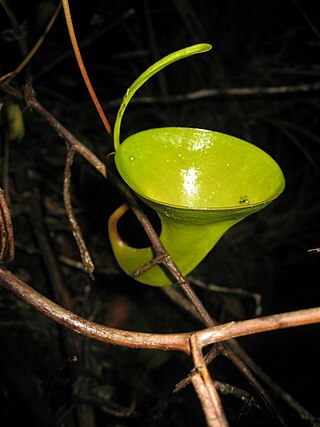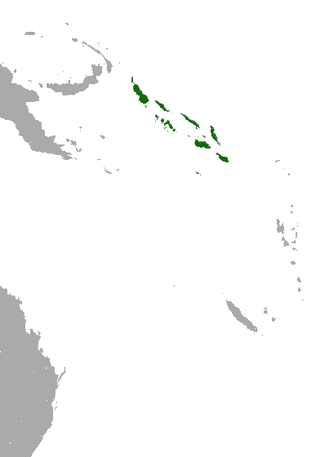
Bromus is a large genus of grasses, classified in its own tribe Bromeae. They are commonly known as bromes, brome grasses, cheat grasses or chess grasses. Estimates in the scientific literature of the number of species have ranged from 100 to 400, but plant taxonomists currently recognize around 160–170 species.

Nepenthes inermis is a tropical pitcher plant endemic to the Indonesian island of Sumatra. The specific epithet inermis is Latin for "unarmed" and refers to the upper pitchers of this species, which are unique in that they completely lack a peristome.

Stomatosuchus is an extinct stomatosuchid neosuchian from the Late Cretaceous (Cenomanian) of Egypt. Much of what is known about Stomatosuchus has been inferred from the related genus Laganosuchus.

Nepenthes × pyriformis is a natural hybrid involving N. inermis and N. talangensis. It is known only from Mount Talang in Sumatra, to which N. talangensis is endemic. Nepenthes talangensis was only described as a distinct species in 1994. Prior to this it was placed within N. bongso and some of the older literature identifies this hybrid as N. bongso × N. inermis.

The Solomon's naked-backed fruit bat is a species of megabat in the family Pteropodidae. It is endemic to the Solomon Islands.

Sepiella inermis is a species of cuttlefish in the family Sepiidae. S. inermis is indigenous to the Indo-Pacific region. In this region, Sepiella inermis is an economically important species, and is sold and eaten.

Coelioxys sodalis is a bee from the family Megachilidae, one of numerous kleptoparasitic bees in the tribe Megachilini. Members of the genus Coelioxys exhibit kleptoparasitic behavior in that they lay their eggs in the nests of other bees, typically those of the related genus Megachile. As this behavior is similar to that of cuckoos, such bees are referred to as cuckoo bees. These host-parasite relationships are complex. Host insects of the brood parasite C. sodalis include Megachile melanophaea, M. texana, and M. rotundata.

Coelioxys, common name leaf-cutting cuckoo bees or sharp-tailed bees, is a genus of solitary kleptoparasitic cuckoo bees belonging to the family Megachilidae.
Coelioxys apicata is a species of leaf-cutting bee in the genus Coelioxys, of the family Megachilidae.
Coelioxys capitata is a species of leaf-cutting bee in the genus Coelioxys, of the family Megachilidae. It is found in India, and recordings from Sri Lanka are uncertain, but considered true.
Coelioxys fenestrata is a species of leaf-cutting bee in the genus Coelioxys, of the family Megachilidae. It is found in India, and recordings from Sri Lanka is uncertain.
Coelioxys minuta is a species of leaf-cutting bee in the genus Coelioxys, of the family Megachilidae. It is found in India, and recordings from Sri Lanka is uncertain.
Coelioxys formosicola is a species of leaf-cutting bee in the genus Coelioxys, of the family Megachilidae.

Coelioxys hunteri is a species of hymenopteran in the family Megachilidae.
Coelioxys slossoni is a species of bee in the family Megachilidae.

Coelioxys sayi is a species of bee in the family Megachilidae.

Coelioxys coturnix is a species of bee in the family Megachilidae.

Coelioxys elongata is a Palearctic species of sharp-tailed bee.












